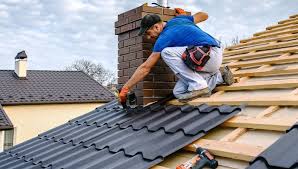Energy efficiency is a term often associated with windows, appliances, and insulation. Yet one of the most impactful components of your home’s energy performance lies above your head—the roof.
When thinking about replacing your roof, energy savings might not be the first benefit that comes to mind. However, a well-executed roof replacement can lead to measurable improvements in indoor comfort and a noticeable drop in your energy bills.
Let’s explore how the right roofing system, combined with the right materials and construction techniques, plays a vital role in regulating your home’s temperature year-round.
The Role of the Roof in Energy Conservation
Roofs don’t just protect against weather; they help manage how much heat enters or escapes your home. Especially in areas with hot summers or cold winters, roofing systems act as the first barrier against temperature transfer.
An outdated or poorly maintained roof can become an energy drain. Cracked shingles, compromised underlayment, or a lack of ventilation allows unwanted heat to enter in summer or escape in winter. When this happens, your HVAC system must work overtime—raising energy consumption and utility costs.
A new roof, by contrast, can drastically reduce thermal exchange and maintain a more consistent indoor environment.
Reflective Materials: Cooling Efficiency Starts Here
Modern roofing materials are far more energy-conscious than their older counterparts. In fact, many of today’s shingles and coatings are designed with solar reflectivity in mind.
Known as “cool roof” technology, these materials reflect more of the sun’s rays instead of absorbing them. As a result, attic temperatures remain lower, and less heat radiates into the home’s interior. This is especially beneficial for single-story homes where the ceiling is closer to the roof surface.
With the right selection, a roof replacement can lower peak cooling demand and reduce summer air conditioning costs by 10–20% or more.
Ventilation: A Crucial Yet Overlooked Factor
While materials matter, so does the airflow. Proper ventilation is essential to maintaining energy balance inside the home.
During warmer months, heat builds up inside the attic. Without proper ventilation, this trapped heat seeps into living areas, making rooms hotter and more difficult to cool. In colder seasons, poor ventilation contributes to moisture accumulation and ice dam formation, both of which can damage insulation and raise heating costs.
A modern roofing system incorporates ridge vents, soffit vents, and exhaust pathways to circulate air naturally. This passive system reduces internal pressure on HVAC units and helps prevent long-term structural issues tied to humidity.
Insulation Boosts from Above
In some roof replacement projects, homeowners also opt to upgrade the insulation beneath the roofing deck. Though insulation is typically associated with walls and floors, the roofline is just as important.
Insulated sheathing or spray foam under the roof deck can significantly reduce heat flow. Some modern roofing systems even include thermal barriers integrated directly into the materials, offering a dual layer of protection.
This combination of updated roofing and enhanced insulation creates a buffer that allows for year-round temperature control—meaning your home stays cooler in summer and warmer in winter with less energy output.
Air Sealing for Efficiency
Every gap or crack in your roof represents a potential leak—not just for water, but for air. Over time, seals around flashing, chimneys, skylights, or vents begin to degrade, creating tiny openings that allow conditioned air to escape.
A full roof replacement is an opportunity to tighten up your home envelope. During installation, roofers can reseal all vulnerable areas, reinforce flashing, and apply protective barriers that limit airflow.
The impact? Less warm air escapes in the winter. Less hot air invades in the summer. And your heating and cooling systems enjoy a longer, more efficient lifespan.
Energy Savings Beyond the Utility Bill
Though energy efficiency often gets measured in dollars, its impact extends further.
- Increased Comfort: Temperature swings are reduced, and rooms stay more consistent in climate—especially on upper floors.
- Better Air Quality: Improved ventilation helps reduce indoor pollutants, humidity, and the potential for mold growth.
- Lower Carbon Footprint: By using less electricity or fuel, energy-efficient homes contribute less to greenhouse gas emissions.
Over time, these benefits compound, creating a more livable space that aligns with both financial and environmental priorities.
Long-Term Return on Investment
A roof is a major expense—but also one of the most practical upgrades for boosting long-term home value. While curb appeal and weather protection are obvious perks, energy efficiency is increasingly important to buyers.
Homes with recent roof replacement often command higher prices in the real estate market, especially when paired with documentation that shows reduced utility costs or the use of sustainable materials.
For homeowners who plan to stay put, the return comes in the form of monthly savings and greater control over interior climate. For those planning to sell, it becomes a marketable feature that sets the property apart.
Choosing the Right Team
While materials and technology matter, so does the quality of the installation. A properly installed roof performs better, lasts longer, and delivers consistent energy benefits over time.
Working with a reputable company like Ridge Runner Roofing helps ensure that all components—ventilation, insulation, air sealing, and materials—are chosen and installed with efficiency in mind. Even minor details, like the color of the shingles or orientation of roof features, can affect how the system functions under real-world conditions.
Final Thought: It’s More Than Just a New Roof
When approached thoughtfully, a new roof becomes more than a structural necessity—it becomes a smart energy strategy. Instead of simply protecting your home from rain and wind, it actively contributes to lowering your costs and improving comfort every day.
If your current roof is nearing the end of its lifespan, or if you’ve noticed increased heating and cooling bills, it may be time to explore energy-smart roofing solutions.
With the right materials, ventilation, and installation, a modern roof does more than just cover your home. It supports it—economically, environmentally, and efficiently.






